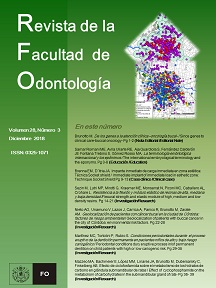The international embryological terminology and the eponyms
Keywords:
international morphological terminology, teaching, research, eponyms, ethicAbstract
In medical language we find a large number of eponyms whose use pays tribute to scientists who described pathology, a sign, a technique, an anatomical or microscopic structure, etc. To pay tribute to those who with their research enriched Medicine and Morphological Sciences particularly and to contribute to the knowledge of the historical Embryology terminology we made an illustrated eponyms glossary for the medical / dental community and the students. To elaborate the glossary, the presence and significance of eponyms in General and Special Embryology books (1950-2018), serial publications, databases and virtual encyclopedias were investigated. Anatomical, Histological and Embryological Terminology Symposia recommend perpetuating eponyms and vernacular folk terms with historical interest only. To use a common scientific language and a single denomination that avoids confusion and optimizes communication and learning, priority should be given to the use of normative terminologyDownloads
References
Alvarez Guisbert O, Campohermoso Rodríguez O. Evolución histórica conceptual de la Terminología Anatómica. Rev Cuadernos 2007; 52: 113-7.
Fuentes R, Bucchi C, Cantín M. Análisis de los términos utilizados en la literatura científica para referirse a los ligamentos extracapsulares de la articulación témporomandibular. Parte 1: Ligamentum sphenomandibulare. Int J Morphol 2014; 32: 981-6.
Losardo RJ, Valverde Barbato de Prates NE, Arteaga-Martínez M, García Peláez MI, Cabral RH. International Morphological Terminology (Anatomy, Histology and Embryology): beyond scientific terms. J Morphol Sci 2017; 34: 130-3.
Algieri RD, Pró EA, Forlizzi V, Ferrante MS. Reseña de la evolución histórica de los términos anatómicos. Rev Arg Anat 2011; 2: 106-11.
Vandaele S, Gingras Harvey M. Les nomenclatures anatomiques: histoire et traduction. Panace@ 2013; 14: 222-34.
Ponte Hernando F. La Nómina Anatómica: historia breve. Cad Aten Primaria 2014; 20: 116-20.
Real Academia Española (RAE). At: www.rae.es. Ultimo acceso: Noviembre 14, 2018.
Federative International Committee on Anatomical Terminology. Terminologia Histologica. International terms for human Cytology and Histology. Philadelphia. FICAT-Wolters Kluwer/Lippincott Williams &Wilkins. 2008: 42-8.
Cruz Gutiérrez R, Rodríguez Torres A, Prates JC, Losardo RJ, Valverde Barbato de Prates NE. Simposio Ibero-latinoamericano de Terminología Morfológica. Características generales. Int J Morphol 2010; 643-6.
Winkelmann A, Noack T. The Clara cell: a “Third Reich eponym?”. Eur Respir J 2010; 36: 722-7.
Clara M. Zur Histobiologie des Bronchalepithels [On the histobiology of the bronchial epithelium]. Z mikrosk anat Forsch. 1937; 41:321-47.
Woywodt A, Lefrak S, Matteson E. Tainted eponyms in medicine: the “Clara” cell joins the list. Eur Respir J. 2010; 36:706-8.
Aja Guardiola S, Olmedo Pérez G, Ríos Más C, Aragón Hernández J, Guajardo Garza ZR, Alemán Castillo JA, Cuellar Salas R, Vela Olivares A,
Domínguez Calderón G. Ética de la enseñanza de la terminología morfológica internacional. 10 preguntas al docente del área morfológica. 2011. En www.histologiavirtual.com.ar. Ultimo acceso: 20 de noviembre, 2018.
Downloads
Published
Issue
Section
License
Aquellos autores/as que tengan publicaciones con esta revista, aceptan los términos siguientes:
- Los autores/as conservarán sus derechos de autor y garantizarán a la revista el derecho de primera publicación de su obra, el cuál estará simultáneamente sujeto a la Licencia de reconocimiento de Creative Commons que permite a terceros:
- Compartir — copiar y redistribuir el material en cualquier medio o formato
- La licenciante no puede revocar estas libertades en tanto usted siga los términos de la licencia
- Los autores/as podrán adoptar otros acuerdos de licencia no exclusiva de distribución de la versión de la obra publicada (p. ej.: depositarla en un archivo telemático institucional o publicarla en un volumen monográfico) siempre que se indique la publicación inicial en esta revista.
- Se permite y recomienda a los autores/as difundir su obra a través de Internet (p. ej.: en archivos telemáticos institucionales o en su página web) después del su publicación en la revista, lo cual puede producir intercambios interesantes y aumentar las citas de la obra publicada. (Véase El efecto del acceso abierto).

